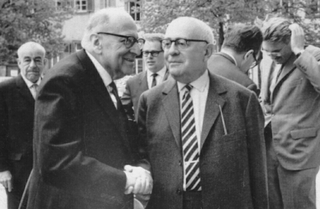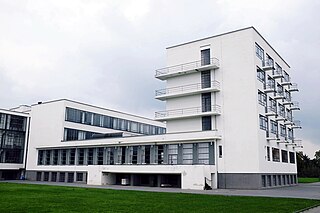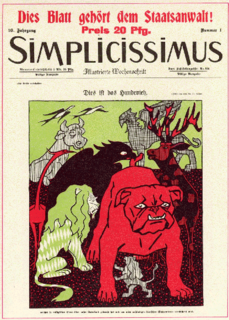 W
WWeimar culture was the emergence of the arts and sciences that happened in Germany during the Weimar Republic, the latter during that part of the interwar period between Germany's defeat in World War I in 1918 and Hitler's rise to power in 1933. 1920s Berlin was at the hectic center of the Weimar culture. Although not part of the Weimar Republic, some authors also include the German-speaking Austria, and particularly Vienna, as part of Weimar culture.
 W
WThe Staatliches Bauhaus, commonly known as the Bauhaus, was a German art school operational from 1919 to 1933 that combined crafts and the fine arts. The school became famous for its approach to design, which attempted to unify the principles of mass production with individual artistic vision and strove to combine aesthetics with everyday function.
 W
WBerge Meere und Giganten is a 1924 science fiction novel by German author Alfred Döblin. Stylistically and structurally experimental, the novel follows the development of human society into the 27th century and depicts global-scale conflicts between future polities, technologies, and natural forces, culminating in the catastrophic harvesting of Iceland's volcanic energy in order to melt Greenland's ice cap. Among critics, Berge Meere und Giganten has the reputation of being a difficult and polarizing novel, and has not received nearly as much attention as Döblin's following novel, Berlin Alexanderplatz (1929).
 W
WBerlin Alexanderplatz is a 1929 novel by Alfred Döblin. It is considered one of the most important and innovative works of the Weimar Republic. In a 2002 poll of 100 noted writers the book was named among the top 100 books of all time.
 W
WThe Berlin Stories is a book consisting of two novellas by Christopher Isherwood: Goodbye to Berlin and Mr Norris Changes Trains. It was published in 1945.
 W
WDie Plage is a large-scale photomontage installation by artist and composer Harley Gaber (1943–2011) consisting of roughly 4,200 canvases that interpret German history from the Weimar Republic to the end of World War II. Gaber worked on Die Plage between 1993 and 2002, incorporating paint, charcoal, and xerography into his photomontage technique, and exhibiting the work in several stages of completion. As of September 2020, Die Plage has not yet been exhibited in its entirety, which would run over 1,680 feet (510 m) long were it displayed as intended in a series of panels, five canvases high, about 12 feet (3.7 m).
 W
WThe Frankfurt School was a school of social theory and critical philosophy associated with the Institute for Social Research, at Goethe University Frankfurt. Founded in the Weimar Republic (1918–33), during the European interwar period (1918–39), the Frankfurt School comprised intellectuals, academics, and political dissidents dissatisfied with the contemporary socio-economic systems of the 1930s. The Frankfurt theorists proposed that social theory was inadequate for explaining the turbulent political factionalism and reactionary politics occurring in 20th century liberal capitalist societies. Critical of capitalism and of Marxism–Leninism as philosophically inflexible systems of social organization, the School's critical theory research indicated alternative paths to realizing the social development of a society and a nation.
 W
WHalbwelt Kultur is a 2012 musical cabaret based on the lives of seven highly influential women of the Weimar Republic.
 W
WJohn Heartfield was a German visual artist who pioneered the use of art as a political weapon. Some of his most famous photomontages were anti-Nazi and anti-fascist statements. Heartfield also created book jackets for book authors, such as Upton Sinclair, as well as stage sets for contemporary playwrights, such as Bertolt Brecht and Erwin Piscator.
 W
WThe Institute for Social Research is a research organization for sociology and continental philosophy, best known as the institutional home of the Frankfurt School and critical theory.
 W
WPaul Kornfeld was a Prague-born German-language Jewish writer whose expressionist plays and scholarly treatises on the theory of drama earned him a specialized niche in influencing contemporary intellectual discourse.
 W
WMetropolis is a tryptych painting by the German artist Otto Dix, executed between 1927 and 1928. The painting depicts three nighttime city scenes from the Weimar Republic. The painting belongs to the Kunstmuseum Stuttgart since it was bought to the artists estate in 1972.
 W
WMezhrabpomfilm, from the word film, and the Russian acronym for Workers International Relief or Workers International Aid, was a German-Russian film studio, formerly Mezhrabpom-Rus, from 1922-1936. The studio was formed from the joining together in 1922 of Moisei Aleinikov, a Russian producer, and Willi Münzenberg, a German communist. The studio was set up in Moscow, with headquarters in Berlin. After producing around 600 films the "international experiment was brutally ended eleven and fourteen years later by Hitler's and Stalin's regimes."
 W
WErich Mühsam was a German-Jewish antimilitarist anarchist essayist, poet and playwright. He emerged at the end of World War I as one of the leading agitators for a federated Bavarian Soviet Republic, for which he served 5 years in prison.
 W
WThe New Objectivity was a movement in German art that arose during the 1920s as a reaction against expressionism. The term was coined by Gustav Friedrich Hartlaub, the director of the Kunsthalle in Mannheim, who used it as the title of an art exhibition staged in 1925 to showcase artists who were working in a post-expressionist spirit. As these artists—who included Max Beckmann, Otto Dix, George Grosz, Christian Schad, Rudolf Schlichter and Jeanne Mammen—rejected the self-involvement and romantic longings of the expressionists, Weimar intellectuals in general made a call to arms for public collaboration, engagement, and rejection of romantic idealism.
 W
WThe New Objectivity is a name often given to the Modern architecture that emerged in Europe, primarily German-speaking Europe, in the 1920s and 30s. It is also frequently called Neues Bauen ("New Building". The New Objectivity remodeled many German cities in this period.
 W
WPaul Klee Notebooks is a two-volume work by the Swiss-born artist Paul Klee that collects his lectures at the Bauhaus schools in 1920s Germany and his other main essays on modern art. These works are considered so important for understanding modern art that they are compared to the importance that Leonardo's A Treatise on Painting had for Renaissance. Herbert Read called the collection "the most complete presentation of the principles of design ever made by a modern artist – it constitutes the Principia Aesthetica of a new era of art, in which Klee occupies a position comparable to Newton's in the realm of physics."
 W
WThe SeSiSo Club was a political and cultural discussion group in Berlin in the 1920s. Its members were of diverse political affiliations. The club had no official existence: its name was derived from the surnames of its chairmen, Hans von Seeckt, Walter Simons and Wilhelm Solf.
 W
WSimplicissimus was a satirical German weekly magazine started by Albert Langen in April 1896 and published until 1967, with a hiatus from 1944–1954. It became a biweekly in 1964. It took its name from the protagonist of Grimmelshausen's 1668 novel Der Abenteuerliche Simplicissimus Teutsch. The headquarters were in Munich.
 W
WDer Sturm was a German art and literary magazine founded by Herwarth Walden, covering Expressionism, Cubism, Dada and Surrealism, among other artistic movements. It was published between 1910 and 1932.
 W
WBruno Julius Florian Taut was a renowned German architect, urban planner and author. He was active during the Weimar period and is known for his theoretical works as well as his building designs.
 W
WA transvestite certificate was a doctor's note issued by the governments of Imperial Germany and the Weimar Republic – under the support of sexologist Magnus Hirschfeld – identifying a person as a transvestite. Transvestite at this time referred to all individuals whose gender identity and preferred clothing was discordant to that associated with their assigned sex, and so included both crossdressing and transgender people.
 W
WUnion of Poles in Germany is an organisation of the Polish minority in Germany, founded in 1922. In 1924, the union initiated collaboration between other minorities, including Sorbs, Danes, Frisians and Lithuanians, under the umbrella organization Association of National Minorities in Germany. From 1939 until 1945 the Union was outlawed in Nazi Germany. After 1945 it had lost some of its influence; in 1950 the Union of Poles in Germany split into two organizations: the Union of Poles in Germany, which refused to recognize the communist Polish government of the Polish United Workers' Party, and the Union of Poles "Zgoda" (Unity), which recognized the new communist government in Warsaw and had contacts with it. The split was healed in 1991.
 W
WWallenstein is a 1920 historical novel by German author Alfred Döblin. Set in Central Europe during the Thirty Years War, the novel's plot is organized around the polar figures of Ferdinand II, Holy Roman Emperor, on the one hand, and Albrecht von Wallenstein, on the other. Döblin's approach to narrating the war differed from prevailing historiography in that, rather than interpreting the Thirty Years War primarily as a religious conflict, he portrays it critically as the absurd consequence of a combination of national-political, financial, and individual psychological factors. Döblin saw a strong similarity between the Thirty Years War and the First World War, during which he wrote Wallenstein. The novel is counted among the most innovative and significant historical novels in the German literary tradition. In large part, contemporary critics found the novel to be difficult, dense, and chaotic—a reception Döblin discussed in his 1921 essay "The Epic Writer, His Material, and Criticism"—yet writers such as Lion Feuchtwanger, Franz Blei, and Herbert Ihering praised Wallenstein for its formal innovation, poetic language, epic scope, and bold departure from other German writing of the time. Despite the novel's difficulty, the critical consensus was that Wallenstein was a major achievement and confirmed the promise seen in Döblin's earlier historical novel, The Three Leaps of Wang Lun.
 W
WThe Weimar Republic, officially the German Reich, also referred to as the German Republic, was the German federal state from 1918 to 1933. As a term, it is an unofficial historical designation that derives its name from the city of Weimar, where its constituent assembly first took place. The official name of the republic remained the German Reich as it had been during the German Empire because of the German tradition of substates.